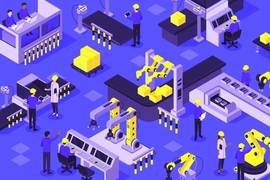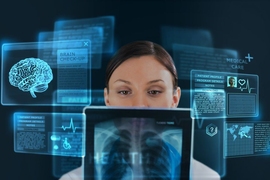Dramatic improvements in information technology have the potential to transform health-care delivery, and a key question is how such changes will affect the health-care workforce of the future. As part of the MIT Task Force on the Work of the Future’s recent series of research briefs, Research Affiliate John Van Reenen teamed with Ari Bronsoler, an MIT PhD student in economics, and Joseph Doyle, the Erwin H. Schell Professor of Management and Applied Economics, MIT Sloan School of Management, to explore the rapidly changing health-care landscape due to the greater availability and use of information and communications technology.
John Van Reenen is a member of the MIT Task Force on the Work of the Future, an MIT Initiative on the Digital Economy Digital Fellow, and the Ronald Coase Chair and School Professor of the London School of Economics. The brief, “The Impact of New Technology on the Healthcare Workforce,” describes the evolution of employment, wages, and education across the wide variety of occupations in the health-care sector since 1980. Here, Van Reenen provides an overview of the work.
Q: Can you describe what health IT is, and its benefits?
A: A key recent technology is the electronic health record, or EHR. This is, at its core, a digitized medical chart. Deriving value from this technology requires a broad array of functions that gather, manage, and share digital health information. This information can then be exploited to support medical decision-making and operations. Ideally, information gathering begins before a patient encounter: retrieving records from other providers or past patient encounters. This, and other information, is then updated at the beginning of the patient’s interaction with the physician or nursing staff; additional data — such as lab values, images, and progress notes — are added as the encounter progresses. This data could, ideally, be made portable so that it may be shared with other providers or accessed via patient portals.
The 2009 Health Information Technology for Economic and Clinical Health (HITECH) Act, part of the Affordable Care Act, provided a major boost to health IT. It allocated around $30 billion to increase the take-up of electronic health records. Although information and communications technology (ICT) has been used in health care since at least the early 1960s, fewer than 10 percent of hospitals (and fewer than 20 percent of physicians) were using EHRs prior to HITECH. By 2014, just about all hospitals had some sort of certified EHR technology.
Another example of an important health IT is telehealth. This provides a new platform to deliver health care at a distance. The coronavirus pandemic has seen rapid take-up of telehealth in the United States and around the world, and this is likely to persist even after the pandemic has abated. Often, large and sudden shocks can speed the switch to a new technology, as it gives multiple players incentives to switch simultaneously (e.g., physicians, patients, and hospital managers). In particular, the decision by Medicare to reimburse telehealth visits during the pandemic provides a valuable opportunity for providers to offer such care in lieu of in-person visits. Other key players in the longer-term evolution are federal and local regulators. Telehealth is particularly attractive for patients in hard-to-reach communities who can be treated via a video connection.
Q: Why is there such a lag time to adopt IT in health care, compared to other industries?
A: The factors that affect the adoption of health IT are similar to those in the broader literature on technological diffusion. Complexity, cost, competition, and complementary factors (such as skilled labor) are all important. But we can point to some factors that are particularly salient to health care: patient safety and privacy, market power, management, and misaligned incentives.
Patient safety: Although health IT offers the potential to improve patient safety substantially, there is a risk that errors may be introduced. The initial adjustment costs in most industries as firms learn how to use IT are well-documented. Because patient safety may be affected by such a transition, there is a natural tendency toward greater risk aversion to all sorts of change in health care, including technology.
Patient privacy: A common concern that affects health IT adoption revolves around privacy. Federal regulation in the form of the Health Insurance Portability and Accountability Act, state-specific laws, and the sheer complexity of legal obligations are thought to reduce the benefits of data sharing and, thus, health IT adoption.
Market power: The EHR market is dominated by just two firms, Epic and Cerner. Many have argued that this lack of robust competition raises prices and thereby slows adoption. Rapid consolidation of the hospital and physician practices sector may have weakened competitive pressure to adopt efficient technologies, although these same forces may provide economies of scale that can promote adoption, especially in light of recent federal subsidies.
Management practices and resistance to change: Many stakeholders can resist change, especially when there are large differences between the IT decision-makers (senior managers) and those who are using the tools (medical staff). Physicians have been found to play a particularly important role here. Without buy-in from senior physicians, it has been found to be very difficult to effectively diffuse IT in health care. Greater involvement in adapting to the new capabilities of health IT among the workforce throughout the health care system could improve acceptance and speed productivity gains while mitigating negative effects on the workforce.
Misaligned incentives: Health care is exceptionally inefficient in generating incentives for innovation and diffusion. First, despite recent payment reforms, most providers continue to operate on a basis where greater provision of care results in greater profits, which means that there is little incentive to seek lower costs through health IT adoption and use. Second, ICT-related coordination is hampered because of the different systems run by competing health care firms.
Q: What do we know about health IT and its impact on jobs, tasks, and skills? What can be done to help workers adapt?
A: There is a vast amount of work on the impact of health IT. Our review of these studies suggests that health IT does, on average, improve clinical outcomes for patients. Like other industries, the effect takes time to feed through because of the need to learn and reorganize the workplace, and the impact of IT varies considerably across different health-care settings (due to the presence or absence of complementary factors such as management quality, workforce engagement, and appropriate skills).
Much less is known about the impact on the workforce. A concern is that technology might automate away the jobs of health workers. Our work, consistent with a small literature, finds no significant job displacement effects or falls in wages. There may be some loss of demand in very specific settings, such as paper-based tasks made more efficient with software or the automation of reading X-rays affecting radiologists. Meanwhile, case study evidence suggests that technology does seem to affect the tasks that workers do, with many routine tasks being automated away. However, the underlying drivers of the growth in demand for health care due to an aging population appear to swamp any displacement effects.
In terms of what can be done to help workers adapt, there are at least two important lessons. Poor training is frequently mentioned as a cause of inefficiency in IT use. Better training helps reduce medical error rates, empowers workers to perform new tasks, and helps define the roles and responsibilities of different health care employees.
Second, engaging workers in the process of change promotes acceptance of the new systems and improves their functioning. Top-down imposition of new technologies and ways of working are often counterproductive.
MIT research affiliate describes benefits, implementation, and potential drawbacks of adopting new technology in health care.
Publication Date:

Caption:
John Van Reenen is a member of the MIT Task Force on the Work of the Future, a MIT Initiative on the Digital Economy Digital Fellow, and the Ronald Coase Chair and School Professor of the London School of Economics.
Related Topics
Related Articles











